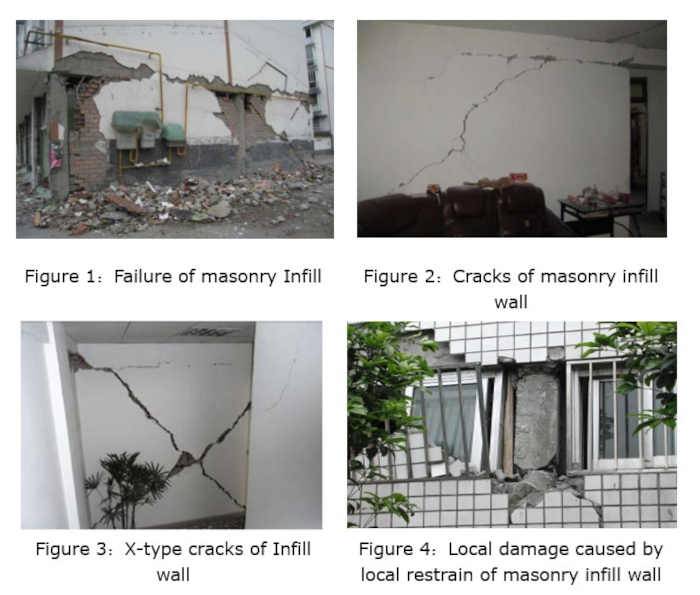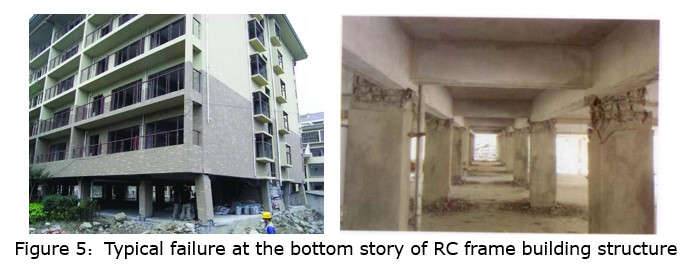Seismic collapse mode of RC frame building structure
The collapse of building structures is one of the main causes of casualties in earthquakes. It is meaningful to study the collapse modes of different types of buildings for enhancing the rescue efficiency to reduce the number of casualties especially immediately after the destructive earthquake.
In this paper, the collapse mode of typical RC frame building structure is briefly described through both of actual earthquake observations and shaking table tests, and the collapse mode of RC frame building structure under earthquake action and the possible spatial distribution characteristics of the trapped occupancies in RC frame building structures are preliminarily summarized.
Generally, the damage of RC frame building structure under earthquakes is mostly concentrated in the bottom story or the lower stories, and the collapse mode mainly performed as the broken-bone-with -connected-tendons type of ruins. As result, possible survival rooms are merely observed available in the upper stories and rarely in lower stories of a building. Accordingly, strategic suggestions for the emergency escape and shelter of occupancies during an earthquake event as well as the emergency rescue measures immediately after the earthquake are suggested respectively.
Seismic collapse mode of RC frame building structure
Overview
Comparing with numerical simulation and scaled model tests in laboratory, seismic damage reconnaissance can provide real and valuable observation data for studying the damage and collapse mechanism of buildings in earthquakes. As one of the most popular building structures all over the world, unexpected countless of collapse cases of the RC frame building structure in destructive earthquakes especially in China caused extensive attention both of engineers and researchers in recent years.
For better understanding the collapse mechanism of the RC frame building structures, this paper briefly reviews collapse cases of RC frame building structures observed from the 2008 Wenchuan 8.0 earthquake reconnaissance and investigations[1][2][3][4]. Generally, except for the characteristics of ground motions, the earthquake damage of RC frame building structures is mainly manifested in the following aspects: (1) most damages are associated with distribution of masonry infill walls; (2) damage severity of column end is more obvious than that of beam end; (3) the bottom story is the most vulnerable story in the building.
Convegno CONCRETE: Criteri di manutenzione degli edifici esistenti e di nuova progettazione nel XXI secolo
Questo articolo è tratto dalle memorie della 6^edizione del Convegno CONCRETE, in cui si è discusso della conservazione degli edifici in calcestruzzo. In particolare, i percorsi di ricerca si sono indirizzati sulle possibilità di utilizzo di tecnologie innovative per il miglioramento delle prestazioni, statiche e sismiche, delle strutture in calcestruzzo armato esistenti anche attraverso l'utilizzo di mix design.
Failure of masonry infill wall and its’ consequences
For frame building structures without obvious weak stories, masonry infill walls usually performed not only as positive factor in term of the first defense line in the lateral resistant structural system but also as negative factor for local critical damage especially to exterior columns between windows under earthquake shaking, as shown in figure 1~figure 4. Existing of the masonry infill can provide additional stiffness to the frame system and the corresponding lateral shear force demands caused by the shorten of natural period of the building structure. The same reason, the local restraint effects of the stiff masonry infills can cause critical “short-column” type of damages to the frame columns between exterior windows even further collapse of the whole building due to the local failure.

Observed column-end damage of RC frame structures
As one of the most famous seismic design principles, "Strong column and weak beam" is the most expected yield mechanism for RC frame building structures. However, in earthquake reconnaissance, it is found that the damage of frame column is obviously heavier than that of beam, and most of the damage occurs at both of the bottom and top end of the column especially in the bottom story of buildings, which mostly demonstrates as flexural failure or flexural-shear coupling failure at the column end close to the beam-column joint. Figure 5 shows the typical damage mode of column in a RC frame building structure observed in Wenchuan M8.0 earthquake.

Typical collapse modes of RC frame building structures
Typically, there two type of collapse modes of RC frame building structures are observed in earthquake rescue site. One is the partially collapsed type with lower stories “disappeared” while upper stories still remained standing and the other one is the totally collapsed type with all stories falling to the ground entirely, as shown in figure 6 and figure 7 respectively.
As the partially collapsed sample, figure 6 shows a hotel building with RC frame structure in 2008 China Wenchuan M8.0 earthquake. It is mainly a reinforced concrete frame building structure with six floors with seven floors partially. During the earthquake, the lower three stories almost completely collapsed and “disappeared”, left a very limited small space for survival occupancies while the upper four stories basically remained normal occupancy space for lucky survivals. From the emergency rescue point of view, the survival chance is very few and would be very difficult for rescue activity in the totally collapsed lower three stories.
L'ARTICOLO CONTINUA...
SCARICA* IL PDF E LEGGI L'ARTICOLO INTEGRALE
*Previa registrazione gratuita al sito di INGENIO
